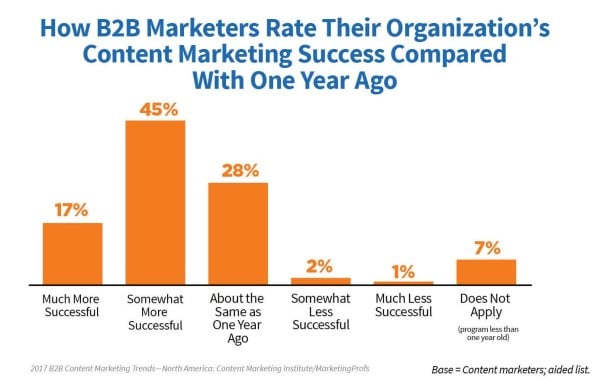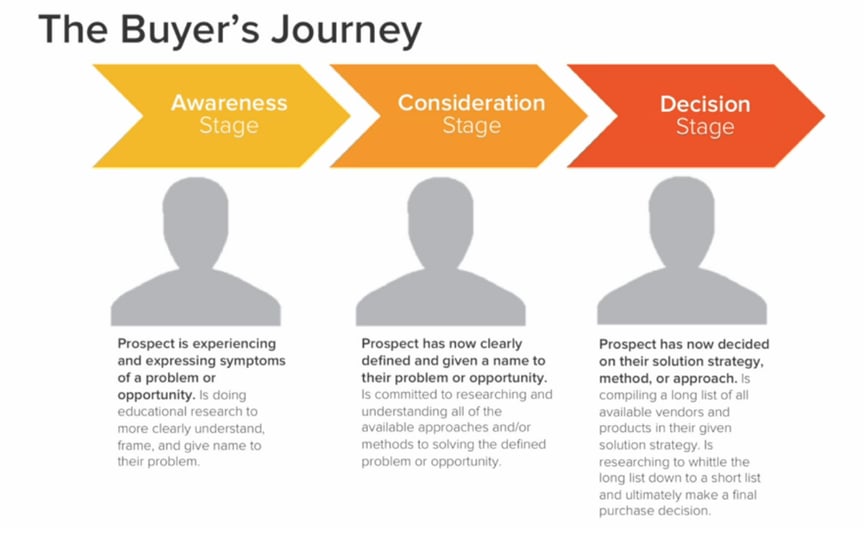How To Create A Waterproof B2B Content Strategy In Half A Day
May I ask you a direct question? How do you feel about your content marketing efforts at the moment? If you are like most B2B marketers, you probably feel a little better about it than the year before.
According to the Content Marketing Institute/MarketingProfs’ B2B Content Marketing 2017: Benchmarks, Budgets, and Trends Survey, 45% of North American B2B marketers felt somewhat more successful, and 28% felt the same regarding their content marketing efforts compared to a year ago.
However, only 17% of the respondents were confident that they were much more successful!

Plan For Content Marketing Success
So, what makes some content marketers more successful than others? Are they simply better writers? Do they have more resources or time to dedicate to creating content?
Let's have a closer look.
According to the same report, there are big differences between those top performers and their less successful peers. Those who identified themselves as more efficacious see greater results from their content marketing because they:
- Do a better job with content creation by publishing higher quality and more efficient content (85%),
- Develop or adjust their content marketing strategy (72%),
- Make Content Marketing a greater priority (53%),
- Spend more time creating content (53%),
- Identify what works and target accordingly (50%),
- Have management & HR support to implement organizational changes, hire for the right content marketing roles (43%),
- And lastly, measure their content marketing effectiveness (42%).
In other words, they know what works and what does not, and they strategically plan accordingly.

In other words, great content marketers know that in order to be effective, you have to deliver differentiated (meaning not regurgitated content like everyone else) stories consistently over time. This takes strategic planning and meticulous execution.
One of the best ways to kick you into high gear for 2017 — and make it your most successful year in terms of content marketing yet — is to create a content strategy plan for the entire year. All it takes is 4.5 hours of work on your end, which will be worth the investment!
And remember, this plan is not set in stone but allows you to put up guardrails against which you can orient yourself throughout the year to make sure you are on target.
So, let's get started.
1) Create A Master Plan Calendar
Time Required: 10 minutes
When planning my annual content strategy, I like to start out by mapping out my year ahead. This way, I don't realize in November (when budget rounds are already in full swing) that I should have thought of creating a B2B Marketing Budget Planning 101 Guide in September! Or, I don't rely on resources over July and August to push out my biggest marketing campaign of the year when everyone is planning on taking vacation.
Based on your industry, your company policies and your team's availability, you should consider adding:
- Relevant holidays, planned out-of-office, maternity leave or vacations times that might impact your team's availability,
- Company internal events such as planned product launches and other milestones that will impact your deliverables, and
- External events relevant in your industry such as tradeshows, conferences, and other events that might have an impact on your campaigns.
Since I am a G Suite user, I keep my Google calendar very organized all-year-round. I automate this process as much as possible since I already imported all US and relevant European holiday calendars. I also have my team members' calendars connected, so gaining visibility into their schedules is easy. However, it is a great idea to ask your team about their 2017 plans at the next team meeting! Then, you can use color-coding to quickly visualize any capacity problems or important deadlines.
2) Review Critical Business, Sales & Marketing Goals
Time Required: 10 minutes
If your fiscal reporting and annual planning align with calendar years, you probably have spent much time in the past few weeks preparing for or sitting in performance review meetings with your executive management, your sales leadership team, and your marketing team. Therefore, reviewing your goals should be a quick and easy task.
However, to my surprise, this step is overlooked in most articles about content planning — for example, here and here!
In my opinion, this is one of the most important 15 minutes you will invest in the entire planning process. Without ensuring that your content helps your company achieve its goals, you are wasting your time!
For your content strategy planning, write down the three to five most important:
- Overarching business goals — Where is my business going next year? What are key priorities that will determine success? How are your executives planning to achieve this?
- Revenue and sales goals — Since modern marketing is increasingly a sales-enablement function, it is critical to be aware of any essential sales-related goals (e.g., the goal to increase annual revenue by 15% by upselling existing customers into higher value plans indicates that you should create content for existing customers rather than spend time on acquiring new customers).
- Transcendent marketing goals or priorities that support the above-outlined business and sales goals.
Write these goals down in an easy-to-access spot. I like to include them in my Asana project description in the Editorial Calendar project.
3) Review Your Sales Funnel To Set Goals
Time Required: 10 minutes
Now that you know what your overall goals look like, you can start breaking them down into content marketing goals.
I found that the best way to do this is by backing into them with the help of your sales funnel. Let me illustrate this with an example.
Let's say you are a software company that sells enterprise software, and your sales team needs to close two large enterprise accounts every month. To do that, you need to give four strategy sessions/product demonstrations. To get to that point, your sales team needs 8-10 qualified exploratory calls with decision-makers, which requires about 20-25 connect calls. If every fourth top-of-the-funnel lead converts into a connect call, you will need to generate about 100 leads monthly. Now, if you know that your conversion rate from website visitor to lead is 3%, then you know that you need to generate 3,000 website visits monthly.
To create this for yourself, you have to know:
- Number of new customers needed per month
- (Top-of-the-funnel) lead-to-opportunity conversion rate
- Number of (top-of-the-funnel) leads
- Visitor-to-lead conversion rate
- Number of website visits per month
Since content marketing takes time, this will be exponential growth and you will probably not meet your goal for the first 3-6 months. But as you create high-quality pieces of content, you will find they will have longevity and generate leads for months and even years to come!
4) Analyze Your Current Content Marketing Efforts For Effectiveness
Time required: 30 minutes
To plan for next year's success, it is always helpful to reflect on what has worked in the past — and what has not.
If you are using HubSpot or another marketing automation platform that lets you easily measure the effectiveness of your blog posts, landing pages, emails, and campaigns, you can find out which topics, content formats, and ways of delivery resonate best with your audience.
Do they prefer long-form How-To blog posts that they can download and save locally as a PDF, or are they more into short and sweet Facebook updates?
In the example below, I took a screenshot from the Blogging Tool in HubSpot. That first blog post was created in October 2015. It still gets more than 2000 views and has a click-through rate of more than 8.5% and generates more than 4.3% of actual submissions. That is the kind of content gem you will want to find in your existing content so you can replicate its success.

On the other hand, also find out what did not perform well. For example, if your audience prefers interactive content, videos or other short-form content, you don't need to waste your time creating blog posts or lengthy eBooks, and can invest your time elsewhere.
5) Review Your Buyer's Journey
Time required: 10 minutes
To be most effective in your content marketing efforts, you also need to consider the decision-making process that your buyers are going through when considering your products. (To learn more about the buyer's journey, click here.)

The content needs change as prospects go through their buyer's journey. While they need help diagnosing a specific problem in the awareness stage (e.g., "10 Reasons Your SaaS Trials Don't Convert Enough Paying Customers"), they are looking for more in-depth research and solution options in the consideration stage ("More Effective SaaS Trails With Lead Nurturing") before moving into the decision stage. Once there, prospects are now looking for information to help them make a purchasing decision, so your content should be solution and product-focused.
Mapping out your buyer's journey will help you later identify content offers you need to create and ensure that you cover all stages of their journey!
6) Create A Realistic Publication Schedule
Time required: 20 minutes
Time to be honest with yourself. It is all too easy to become carried away with all the possibilities of what you could do. But it is crucial to set realistic goals for a strategy to work.
In this step, think about your current team, their work load and capacity:
- Maybe you are planning to hire an agency to help with your content marketing execution?
- How junior or senior is your writing team, as it will take a junior writer more time and many more revisions to finish a blog post than a writer with more experience?
- How will you go about content research and discovery?
- What content formats will you mainly produce?
All these considerations and more will contribute to a publication schedule that your team can handle throughout the year. Then create a social media publishing schedule and a blog post schedule. I suggest that you err on the side of caution, as you want to never sacrifice the quality of your content just to meet unrealistic deadlines.
7) Decide On Overarching Themes & Campaigns
Time required: 30 minutes
By now you have gathered a considerable amount of information. You should know:
- What organizational and seasonal guardrails you have to work around,
- Which kind and how many leads your content marketing efforts need to help generate,
- What content types and topics your prospects are interested in and will convert on, and
- How much content you can realistically produce.
Now it is finally time to translate everything that you've learned into actionable insights. This is the fun part! In order to prioritize, you should decide what themes you should focus on in 2017 and what campaigns you will run.
If you have decided in the previous step that with your growing team it is realistic to tackle one campaign a month, you have 12 campaign slots to fill! Brainstorm these together as a team and consider if there are any overarching themes (e.g., a customer loyalty program) you should structure your campaigns in.
Don't forget to involve your executive management and sales team in this decision early on so they feel ownership in your campaigns and their continued support and buy-in will help you later on to create and distribute your content.
8) Break Down Milestones & Important Deadlines
Time required: 20 minutes
When we plan full campaigns for our clients, we know we will need to create a variety of assets that are required to promote it effectively. For example, a campaign to promote a whitepaper needs to have:
- An optimized conversion path (landing page, thank you page, call-to-action buttons, follow-up email)
- Promotional email to targeted audience
- Promotional blog post
- Blog posts that are closely related to the whitepaper subject
- Social media posts that promote the landing page as well as the blog posts
Depending on which campaigns you will run, you will need to assign different milestones and deliverables. For example, an inbound marketing campaign to promote your booth at a tradeshow requires different deliverables than promoting a webinar.
9) Brainstorm Blog Post Ideas
Time required: 60 minutes
In the previous steps you have built the skeleton of your content marketing stratgey. Now it is time to put some meat on those bones, so to speak.
Put yourself in your customer's shoes and walk through that buyer's journey, focusing on the campaigns and themes you just outlined. Think about which problems you would face or what challenges you would encounter. Maybe there are opportunities that your prospects are not aware of?
Based on your publication schedule, you know how many blog post topics you will need to come up with. If you are stuck, use blog post generators or our blog post brainstorming tips (even though this blog post is written for interior designers specifically, the principle is generally applicable) to help you spark some new ideas.
Also, think about adding seasonal topics. For example, you can run a post titled "5 Reasons Why We Love Our Customers" around Thanksgiving time and come up with creative ways to show why you care about your customers.
To organize your blog post topics, you can use simple Google Sheets or our Editorial Calendar Template, a Trello board or — my favorite — your Asana project management tool.
10) Assign Responsibilities & Deadlines
Time required: 10 minutes
Even the best of strategies will not bear fruit if it is not efficiently executed. You will need to assign responsibilities and deadlines to each campaign, content offer and blog post topic to ensure it gets done on time. Walk your team through their roles and your content creation procress so they are aware of their roles in the overall process.
I hope this is helpful to create your content marketing strategy and will give you a leg up in 2017! And remember, if you need help or just want to pick my brain, I am happy to schedule a free coaching session with you.
Share this
You May Also Like
These Related Stories

Why B2B Technology Marketers Shouldn't Rely On Keywords, But Content Clusters

B2B Content Marketing: How Much Does It Cost Per Month & How Can The Cost Be Reduced?

.png?width=250&height=125&name=TrustBuilderLogoWhiteTranspBackgr(250x125%20px).png)



No Comments Yet
Let us know what you think